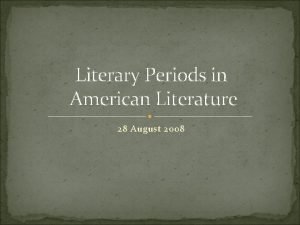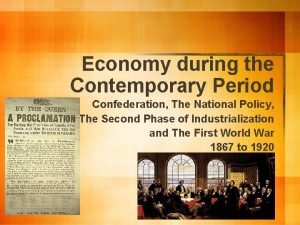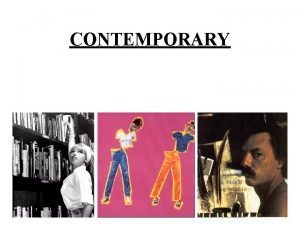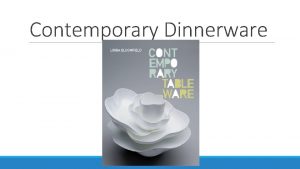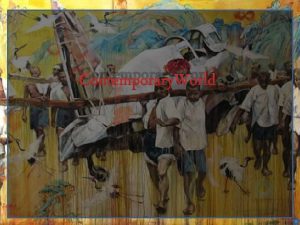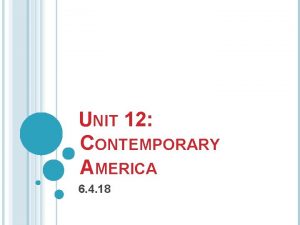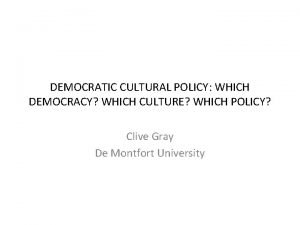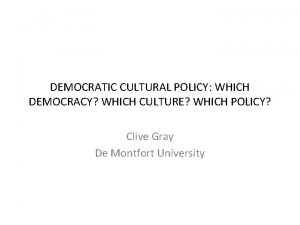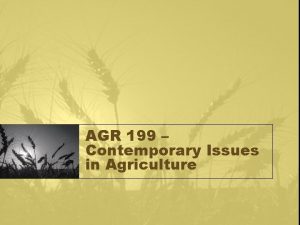Unit 6 Review Contemporary Period Which of the






























































- Slides: 62

Unit 6 Review Contemporary Period

Which of the following is an accurate statement about trends in art and literature after World War I? A. Modernism and experimental methods and materials dominated the art world B. The development of new materials and technology revolutionized architecture. C. The anxiety and uncertainty of the postwar period influenced literature and art D. Governmental censorship of literature during the war resulted in a cultural backlash of anti-government writing.

The Chinese Communist Party adapted Marxist communism to A. accommodate a large peasant population B. allow for capitalistic economic programs C. prevent Russian-style education programs D. justify imperialistic policies in Japan, Taiwan, and Mongolia

Which of the following was an impact of theory of Social Darwinism? A. industrialization led to worker revolts B. Rulers were obligated to protect their citizens C. Europeans justified their domination of colonized people D. Science was viewed as more important than religious belief.

Before World War II, both Japan and Germany A. withdrew from the League of Nations over land disputes B. experienced tremendous growth in the urban middle class C. embraced social reform movements such as universal suffrage D. rebuilt their economies from the impacts of the Great Depression and significant war debts

Which of the following is NOT an accurate statement about the Middle East in the late twentieth century? A. the discovery of new resources of petroleum diluted the political power and military importance of OPEC member nations B. A resurgence of religious fundamentalism was responsible for the political revolutions in a number of nations, such as Iran. C. there was increased tension between efforts to modernize and basic tenets of Islamic law and practice. D. Nationalistic extremism was responsible for genocide and civil war in numerous nations

Which of the following statements about Sun Yat-sen is accurate? A. Sun Yat-sen was the first leader of China who was neither a foreign invader nor part of an imperial dynasty B. The People’s Republic of China founded by Sun Yat-sen was based on a Five Year Plan for economic growth. C. The Chinese Republic was successful in expelling the British from Chin and creating an economically and politically strong nation D. One of Sun Yat-sen’s first tasks as ruler was to purge communists from high-ranking government positions.

Both Gandhi and Mao Zedong A. Agreed on the desirability of effecting change nonviolently B. worked to reform the social order in their respective nations C. believed change must begin at the level of the individual and would involve a spiritual component D. believed in unity among different religious groups

The concept of “total war” in World War I refers to the A. use of troops from African colonies by England, France, and Germany. B. entry of Pacific Rim nations into the Triple Alliance C. involvement of the United States and Canada in a conflict that did not take place within their borders D. mobilization of economic, natural, and human resources for the war effort

The Soviet Union and the People’s Republic of China each used Five- Year plans to A. map out a strategy for the expansion of Communist parties in other nations. B. develop stronger military cooperation between the two countries. C. manage economic policies for agricultural and manufacturing production. D. act as term limits to allow for changeover in political leadership.

During the 1960 s and 1970 s, which of the following contributed to the establishment and continuation of authoritarian governments in the developing world? A. The nonaligned movement B. Cold War tensions between the Soviet Union and the United States C. An abundance of cheap commodities and manufactured goods in the global market D. A decision by the United Nations to respect the sovereignty of each nation regardless of its political organization

What statement best assesses how the Great Depression contributed to the beginning of World War II. A. New democratic governments failed to deal with the economic crisis caused by the Depression, allowing more radical political ideologies like fascism to take hold in their countries. B. The economic turmoil created the need to expand colonial possessions in order to secure scarce resources. C. The economic decline actually encouraged all nations to reduce military spending and attempt to maintain the peace much longer than in previous decades. D. Governments attempted to use military action to promote nationalism and to distract people from the failure of economic policies to alleviate the crisis.

Article 2 …any of the following acts committed with intent to destroy, in whole or in part, a national, ethnical, racial or religious group, as such: • Killing members of the group; • Causing serious bodily or mental harm to members of the group; • Deliberately inflicting on the group conditions of life calculated to bring about its physical destruction in whole or in part; • Imposing measures intended to prevent births within the group; • Forcibly transferring children of the group to another group. The above article, adopted by the United Nations General Assembly in 1948, defines what as a crime under international law? A. Torture B. War C. Genocide D. Terrorism

After seizing control of Egypt, what larger policy was promoted by Gamal Nasser in order to strengthen his position internationally? A. Pan- Africanism B. Communism C. Nonalignment D. Pan- Arabism

Which of the following was a common result after independence was achieved in an African nation? A. Movement toward a representative government to integrate the various ethnic groups into a common society B. The deliberate isolation of the nation from international politics so as to avoid a new form of imperialism based on economic domination C. The establishment of strong regional alliances to promote economic growth without dependence on developed nations D. The breakdown of society into ethnic rivalries, leading to internal conflict

Which of the following was NOT an aspect of the colonial struggle for independence between Algeria and France? A. The presence of large numbers of French citizens in the Algerian colony B. Divided public opinion in France over military action in Algeria C. Direct intervention by the Soviet Union in assistance to the Algerian rebels D. The use of terror attacks against French citizens in Algeria

Which of the following best describes the Indian National Congress? A. A group of Indian nationalists who, disappointed in the failure of the 1857 rebellion/mutiny, banded together to organize opposition to British rule B. A group of educated Indians who joined together to press for greater autonomy within British India C. A radicalized group of Indians who banded together to promote attacks upon British authorities in India D. A pacifist movement organized by Indian Hindus to oppose outside influences in India

Which of the following statements is an accurate comparison of the Ottoman, Russian, and Qing Empires in the late nineteenth and early twentieth centuries? A. Prior to their collapse, each of the empires attempted a series of Western- style reforms, but the ruling elites eventually failed to support the needed changes. B. Overexpansion of empires caused each to face economic turmoil as taxes were increased to pay for military expenditures. C. The Ottoman and Russian Empires survived because of the adoption of some Western- style reforms while the Qing failed because it refused to alter centuries of Chinese tradition. D. The Ottoman Empire and Qing dynasty both lost territory to aggressive European powers while Russia, acting as an aggressor, expanded its empire during this time.

During World War I, what new military technique led to unprecedented numbers of combat deaths? A. Submarine warfare B. Atomic weapons C. Trench warfare D. Aerial combat

In the early twentieth century, what scientist developed a set of new theories that challenged Sir Isaac Newton’s position as the leading theoretical physicist? A. Sigmund Freud B. Marie Curie C. Max Planck D. Niels Bohr

In 1900, European, American, and Japanese troops landed in China to put down a rebellion initiated by the Society of the Righteous Harmonious Fist, called Boxers by Westerners, because A. even though the Westerners did not favor the Qing dynasty, they did not want it replaced by a stronger Chinese government. B. of treaty obligations the Western governments and Japan had negotiated with the weak Qing dynasty. C. the Boxers’ goal was the expulsion of foreigners and their influence from China. D. the rebellion provided an excuse to permanently station Western troops in China based on a series of previous treaty agreements.

In what colony did slavery result in a successful slave rebellion that established an independent state? A. Brazil B. Haiti C. Colombia D. Jamaica

The events of the second passage were allowed to happen because the agreement reached in Berlin A. did not apply to Belgium. B. failed to include the use of coerced labor in its protections. C. did not include any formal requirement that nations enforce the obligations it established. D. failed to include any means of monitoring the actions of nations in the Congo to make sure they fulfilled their obligations.

Why was Communism viewed as a threat in industrial nations like Great Britain and Germany? A. Communism required greater participation of the working poor in government. B. Communism called for the violent overthrow of those in power and did not protect private property. C. Communism demanded an end to the colonial system so that workers in the home nations could demand better pay and benefits. D. Communism would create a political system that did not protect the special privileges of the nobility or middle class.

“The yellow and white races which are to be found on the globe have been endowed by nature with intelligence and fighting capacity. They are fundamentally incapable of giving way to each other. Hence, glowering and poised for a fight, they have engaged in battle in the world of evolution, the great arena where strength and intelligence have clashed since earliest times, the great theater where for so long natural selection and progress have been played out. ” The quotation above by an early-twentieth century Chinese revolutionary illustrates the influence of A. Social Darwinism B. communism C. National Socialism D. anarchism

“We shall not repeat the past. We shall eradicate it by restoring our rights in the Suez Canal. This money is ours. The canal is the property of Egypt. ” The quotation above by Egyptian leader Gamal Abdel Nasser (in power 1952– 1970) best expresses support for (A) communism (B) liberalism (C) nationalism (D) imperialism

“Nevertheless for more than eighty years, the French imperialists, abusing the standard of Liberty, Equality and Fraternity, have violated our Fatherland oppressed our fellow-citizens. They have acted contrary to the ideals of humanity and justice. ” Declaration of Independence of the Democratic Republic of Viet Nam, 1945 The excerpt above was written in response to which of the following? (A) The use of Vietnamese laborers and soldiers by the French in the First World War (B) The end of the struggle for Vietnamese independence known as the Indochina wars (C) The failure of French colonizers to apply their ideals in Indochina (D) The rapid conquest of French Indochina by the Japanese during the Second World War

After the Second World War, countries around the world did which of the following to restore the global economy? (A) Created the European Union to coordinate European economic aid to former colonies. (B) Developed a common economic aid package for African and Asian states. (C) Established new financial institutions, such as the World Bank. (D) Allowed the United Nations to take over failing national economies.

Nationalist leaders in Africa and Asia, such as Ho Chi Minh (1890– 1969), Jomo Kenyatta (1894– 1978), and Kwame Nkrumah (1909– 1972), had which of the following in common? (A) Defense of capitalism (B) Support for free-trade systems (C) Rejection of violent revolution (D) Opposition to colonial rule

Which of the following statements is true about the world at the end of the twentieth century? (A) The standard of living in the least economically developed countries of the world rapidly approached that of the most developed countries. (B) The pace and intensity of international contacts accelerated as a result of transportation and communication breakthroughs. (C) The world balance of power was reversed as the West no longer had a military advantage over non-Western countries. (D) World religions were in decline as the spread of science and secularism intensified.

Which of the following best describes the 1936 lithograph (entitled The Hero)by German artist George Grosz? (A) A propaganda poster prepared by the Nazi Party (B) A protest poster against the atrocities of the atomic bomb (C) A representation of a Holocaust victim (D) A post-First World War print expressing antiwar sentiment

The founding North Atlantic Treaty Organization (NATO) is best understood in the context of which of the following? (A) The Cold War (B) The growth of a globalized economy (C) The establishment of the Nonaligned Movement (D) The post-Second World War population boom

Historians argue that the twentieth century marks a significant break in world history for all of the following reasons EXCEPT: (A) Petroleum use fundamentally changed the relationship of humans to the environment. (B) The population of the world increased from 1. 6 billion to 6. 1 billion people. (C) Communists established powerful new states in Russia and China. (D) Low-wage laborers migrated from continent to continent.

Most world historians would agree that the key to European predominance in the world economy during the nineteenth and early twentieth centuries was (A) the Industrial Revolution (B) European medical technology (C) Spanish control of New World silver (D) the Enlightenment

What was the leading cause of the unprecedented increase in global population in the twentieth century? (A) The end of international epidemics (B) Global warming and other types of climate change (C) The impact of medical innovations and public health measures (D) The reduction of world hunger

In recent decades, many world historians have challenged the commonly held view that Europeans controlled the largest share of world trade in the seventeenth through the eighteenth centuries. Which of the following evidence from the period would best support this historical reinterpretation? (A) Prices for Chinese goods were much higher in Europe than in China. (B) European trading companies often backed their long-distance trading ventures with the threat of military force. (C) Asian trading companies dominated trade in the Indian Ocean region. (D) European merchants transported only a fraction of the goods shipped globally.

Which of the following statements best represents a nationalistic interpretation of the collapse of the Ottoman and Russian empires during and immediately after the First World War? A. Military weakness and political instability were the primary reasons for the collapse of these empires. B. The growing demands of various ethnic groups within these multiethnic empires were the primary reasons for the collapse. C. The slow pace of industrialization in these empires left them unable to compete militarily and politically with more developed countries. D. Religious differences between the Russian Empire and the Ottoman Empire led to their final collapse.

Which of the following was a major similarity between the goals of leaders of the Chinese Communist Revolution, such as Mao Zedong, and the goals of leaders of the Mexican Revolution, such as Emiliano Zapata, in the early twentieth century? (A) Advocacy of a global workers’ revolution (B) Active encouragement for integration into the global economy (C) Concern primarily with improving conditions for urban factory workers (D) Support for redistribution of land to poor peasants

Which of the following was a significant environmental effect of the globalization of the world’s economy in the period 1980 to the present? (A) There was a significant improvement in air and water quality worldwide. (B) While air and water quality generally improved in the developed world, they deteriorated in many parts of the developing world. (C) Emissions of greenhouse gasses that contribute to global warming generally decreased. (D) While biodiversity decreased in the developing world, it generally increased in the developed world.

Some historians consider the late nineteenth century and early twentieth century to have been crucial decades in the development of Western thought. Which of the following best supports that contention? (A) Discoveries in physics introduced the concepts of uncertainty and relativity, which challenged mechanistic models of the universe. (B) Christian missionaries introduced strains of relativism into Western thought after encountering cultures with radically different world views. (C) Efficiency experts employed scientific methods to regulate the workplace and thereby encouraged faith in economic progress. (D) Visual artists inspired by photography made realism the dominant aim of painter and sculptors.

Which of the following is NOT true concerning globalization? A. Child labor is common in South Asia and Southeast Asia. B. Regional trade organizations have risen in response to the World Trade Organization. C. Guest workers have been frequent victims of violence. D. The AIDS crisis is especially prevalent in Southeast Asia.

All of the following were true of the Iranian Revolution EXCEPT that A. it was led by Islamic fundamentalists. B. it led to more restrictive policies for Iranian women. C. it resulted in a war with Iraq. D. it reflected pro-foreign sentiment.

The world region that has experienced the most rapid recent industrial growth is A. North America. B. Latin America. C. North Africa. D. East Asia.

In the twentieth century, external migration patterns were usually A. from rural to urban areas. B. from urban to rural areas. C. from developed to developing nations. D. from developing to developed nations.

The country with the largest Muslim population is located in A. the Middle East. B. Southeast Asia. C. East Asia. D. North Africa.

In which order did the following events occur? A. Suez crisis, creation of Israel, Iranian revolution, Iran-Iraq War B. Iranian revolution, Suez crisis, creation of Israel, Iran-Iraq War C. Creation of Israel, Suez crisis, Iranian revolution, Iran-Iraq War D. Creation of Israel, Iranian revolution, Iran-Iraq War, Suez crisis

Which of the following was NOT a Cold War strategy? A. the Soviet Union provided Middle Eastern nations with military supplies and advisors B. the United States supported totalitarian dictatorships in some Latin American and Middle Eastern countries C. Both the Soviet Union and the United States renewed colonization of lands in Latin America and the Middle East. D. The United States and Soviet Union built up huge arsenals of traditional, biological, and nuclear weapons in order to prevent war.

The ability of nations to industrialize required all of the following conditions EXCEPT A. a reliable source of fuel B. surplus population C. improved farming techniques D. a network of colonies

Which of the following terms is NOT associated with the Cold War? A. Brinkmanship B. Peaceful coexistence C. Mutual Assured Destruction D. Appeasement

As a result of Bismarck’s Berlin Congress’ plan to partition Africa A. Germany controlled a substantial portion of Africa B. the United States entered the scramble for Africa C. the slave trade with Europe, North America, and South America was halted D. only two African nations remained free at the beginning of the twentieth century.

The globalization of American culture has resulted in A. anti-Western backlash in some developing nations B. increased access to health care and education C. additional tariffs on American-made goods D. more cultural tolerance around the world.

Which of the following nations is NOT a declared nuclear state? A. People’s Republic of China B. Great Britain C. France D. Argentina

The Eastern Question concerned A. how European nations would fairly partition the continent of Africa B. the manner in which Prussia, Austria, and the Ottoman Empire would maintain the balance of power in Europe C. the opening of port cities in China, Japan, and Korea to foreign trade D. how to fill the void left by the decline of the Ottoman Empire

The changes that took place in Russia in the 1990’s demonstrated A. that modernization is a requirement for long-term social and political stability B. that cultural and ethnic differences between segments of the population will undermine attempts at nationalism C. that there are inherent problems in an economy governed through central planning D. that the development of a substantial middle class can bring about political change.

Which of the following was NOT an outcome of World War I? A. The League of Nations called for disarmament and global security B. The Treaty of Versailles required Germany to pay war reparations C. France and Great Britain granted independence to their colonial lands in India and Africa D. A policy of isolationism within the US Congress prevented the United States from aggressively becoming involved in world affairs

Which of the following is NOT an accurate statement about British rule in India? A. British rule led to the modernization of India’s infrastructure B. There was less conflict between Muslims and Hindus under British rule C. The Sepoy Rebellion of 1857 was successful in ousting the British from India D. the caste system was not eliminated with the introduction of Western culture.

Which of the following was a cause of both World War I and World War II? A. Political instability in the nations of eastern Europe B. the complicated network of secret alliances forged by European nations C. The massive debt owed by Germany to other parts of the world D. The inability of the League of Nations to enforce its decisions

Which of the following actions had the most direct impact of the dissolution of the Soviet Union? A. The official unification of Germany and the demolition of the Berlin Wall B. Public awareness of the human rights atrocities committed by the regime of Nicolae Ceausescu in Romania C. Labor disputes and working-class resistance to communist rule in Poland D. The imposition of martial law in Czechoslovakia after the Velvet Revolution

Which of the following is the most important factor in bringing about the end of the Cold War? A. the breakdown of diplomatic relations between Soviet Union and China B. The economic costs to both the United States and the Soviet Union required to sustain the conflict C. The end of civil conflicts in Southeast Asian countries such as Cambodia, the Koreas, and Vietnam D. The spread to other nations of nuclear technology and the ability to create weapons of mass destruction

The ability of developing nations to establish stable economies is compromised by all of the following EXCEPT: A. problems attracting foreign investment and multinational corporations B. cultural, tribal, and ethnic differences that threaten political stability C. insufficient physical infrastructure, such as railways and roads D. the inability to attract a sufficient workforce to urban areas

Which of the following is an accurate statement about Ethiopia and Thailand before 1915? A. They both remained the only free nations in their regions B. They both gained their freedom in peaceful revolutions C. Civil wars in each country toppled monarchies and installed democracies D. The citizens of both nations were converted to Islam before 1915

The most important impact of the demilitarization of Japan after World War II was the A. increase in anti-American sentiment and protest throughout Japan B. restoration of the Meiji Empire and a return to a more traditional society C. Reassignment of Japan’s colonies to the United States D. ability to devote a significant share of Japan’s budget to industrialization
 Unit 10, unit 10 review tests, unit 10 general test
Unit 10, unit 10 review tests, unit 10 general test What are literary periods
What are literary periods Contemporary period
Contemporary period Algebra 2 unit 1 test answers
Algebra 2 unit 1 test answers Critical period vs sensitive period
Critical period vs sensitive period Absolute refractory period and relative refractory period
Absolute refractory period and relative refractory period Absolute refractory period and relative refractory period
Absolute refractory period and relative refractory period Critical period vs sensitive period
Critical period vs sensitive period Critical period
Critical period Approaches to child development
Approaches to child development Classical period 1750 to 1820 romantic period
Classical period 1750 to 1820 romantic period Nonmetal halogen family, atomic mass 35
Nonmetal halogen family, atomic mass 35 The seed of activism
The seed of activism Stability period vs measurement period
Stability period vs measurement period Trustee period and royal period
Trustee period and royal period Difference between historic period and prehistoric period
Difference between historic period and prehistoric period Period 2 apush review
Period 2 apush review Period 3 key concepts apush
Period 3 key concepts apush Apush period 9 review
Apush period 9 review Sunbelt apush
Sunbelt apush Period 2 apush
Period 2 apush Apush review period 6
Apush review period 6 Hát kết hợp bộ gõ cơ thể
Hát kết hợp bộ gõ cơ thể Frameset trong html5
Frameset trong html5 Bổ thể
Bổ thể Tỉ lệ cơ thể trẻ em
Tỉ lệ cơ thể trẻ em Chó sói
Chó sói Tư thế worms-breton
Tư thế worms-breton Chúa yêu trần thế alleluia
Chúa yêu trần thế alleluia Môn thể thao bắt đầu bằng từ đua
Môn thể thao bắt đầu bằng từ đua Thế nào là hệ số cao nhất
Thế nào là hệ số cao nhất Các châu lục và đại dương trên thế giới
Các châu lục và đại dương trên thế giới Công thức tính thế năng
Công thức tính thế năng Trời xanh đây là của chúng ta thể thơ
Trời xanh đây là của chúng ta thể thơ Mật thư anh em như thể tay chân
Mật thư anh em như thể tay chân Phép trừ bù
Phép trừ bù Phản ứng thế ankan
Phản ứng thế ankan Các châu lục và đại dương trên thế giới
Các châu lục và đại dương trên thế giới Thơ thất ngôn tứ tuyệt đường luật
Thơ thất ngôn tứ tuyệt đường luật Quá trình desamine hóa có thể tạo ra
Quá trình desamine hóa có thể tạo ra Một số thể thơ truyền thống
Một số thể thơ truyền thống Cái miệng bé xinh thế chỉ nói điều hay thôi
Cái miệng bé xinh thế chỉ nói điều hay thôi Vẽ hình chiếu vuông góc của vật thể sau
Vẽ hình chiếu vuông góc của vật thể sau Thế nào là sự mỏi cơ
Thế nào là sự mỏi cơ đặc điểm cơ thể của người tối cổ
đặc điểm cơ thể của người tối cổ Ví dụ giọng cùng tên
Ví dụ giọng cùng tên Vẽ hình chiếu đứng bằng cạnh của vật thể
Vẽ hình chiếu đứng bằng cạnh của vật thể Vẽ hình chiếu vuông góc của vật thể sau
Vẽ hình chiếu vuông góc của vật thể sau Thẻ vin
Thẻ vin đại từ thay thế
đại từ thay thế điện thế nghỉ
điện thế nghỉ Tư thế ngồi viết
Tư thế ngồi viết Diễn thế sinh thái là
Diễn thế sinh thái là Các loại đột biến cấu trúc nhiễm sắc thể
Các loại đột biến cấu trúc nhiễm sắc thể Số nguyên tố là
Số nguyên tố là Tư thế ngồi viết
Tư thế ngồi viết Lời thề hippocrates
Lời thề hippocrates Thiếu nhi thế giới liên hoan
Thiếu nhi thế giới liên hoan ưu thế lai là gì
ưu thế lai là gì Sự nuôi và dạy con của hổ
Sự nuôi và dạy con của hổ Khi nào hổ mẹ dạy hổ con săn mồi
Khi nào hổ mẹ dạy hổ con săn mồi Sơ đồ cơ thể người
Sơ đồ cơ thể người Từ ngữ thể hiện lòng nhân hậu
Từ ngữ thể hiện lòng nhân hậu

